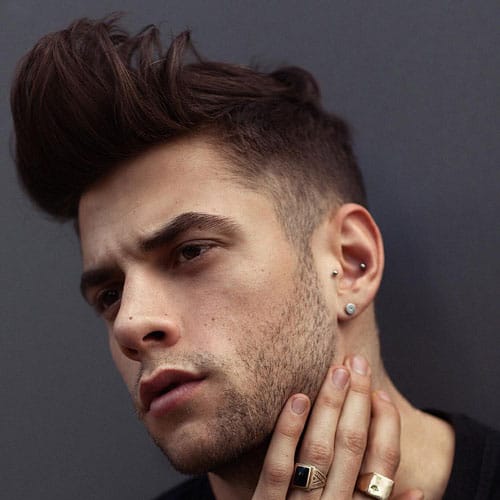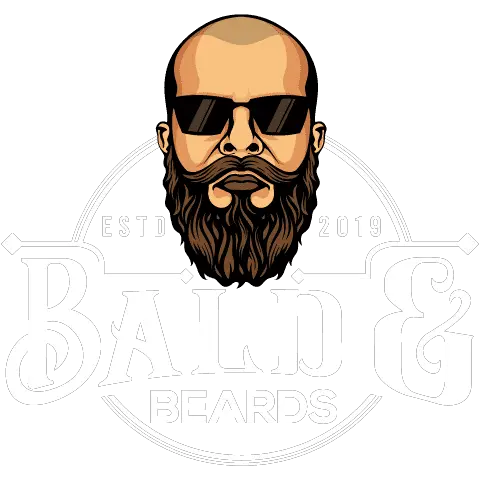Beards have a lot of benefits. Beard growth will enhance a man’s features and sculpt a fresh new look. Understanding your natural beard growth stages will help when you start growing your ultimate beard.
Beards develop in growth stages and are unique to each beardsman. There are many factors that will affect how your beard grows such as age, shave routine and beard care. Identifying each stage can help you forecast your own growth timeline.
There are several beard growth stages you must know first as you embark. These tips and beard care ideas can help you stick it out even when your beard doesn’t come in fully within a few days. Read the full guide below.
Thinking of What You’d Look Like with a Beard?
Before getting into the stages, you should know that there are some amazing benefits to growing a thick beard. If you ever think about picking up the razor and shaving it all off, you should come back to these benefits. They’ll keep you pushing forward with your beard growth.
Protect Your Face
Are you out in the sun a lot? Whether you love going to the beach or like to spend time outdoors, men with a lot of skin exposure typically develop leathery skin.
However, those with beards have a layer of protection. Studies show that beards block 95 percent of all harmful UV rays.
Stay Warmer
As the temperature dips into the 50s, 40s, 30s, and lower your beard actually protects your face from harsh winds and the cold. It’s a barrier that can protect you from these harsh, icy winds.
While wind and cold weather may cause dry skin or chapping, you can use your beard as thermal protection.
Defend Against Throat Disease
Did you know that studies have found facial hair keeps airborne bacteria out of your mouth, which helps protect your throat against diseases? Dr. Addison Dutcher documented this in 1875 in the “Pulmonary Tuberculosis”.
Beards are Trending Again
Men with beards are incredibly attractive, especially when kept trim and oiled. If you maintain your beard growth, you can also define your facial shape.
If you want a more square jaw or a strong mustache, you can trim and sculpt your hair to align with your cheekbones and facial width.

The German company Braun asked 1,000 men from New York about their grooming practices. Of these surveyed, 67 percent said that they sport facial hair because they feel more attractive with hair on their chin. In fact, 55 percent said that they received more compliments because of their facial hair.
No More Shaving
It’s actually much easier to simply shampoo and condition your beard like your hair in the shower rather than shaving it all off whenever you have stubble. You’ll save time every morning just by maintaining beard growth.
Some studies have found that men spend an estimated 3,350 hours shaving their beard over a lifetime. That’s 139 days that you’ll have saved by growing out your beard.
Studies Show Beards Lead to More Sex
In the 1970s, a study was quoted in The Dependent Gene, which found a thread between beard growth and sex. The experiment found that the stimulus for beard growth is related to sexual activity. When the likelihood of sexual activity is higher, testosterone also increases, and your beard may grow in thicker.
Another 2008 study found that women rated men with stubble as more mature, tough, aggressive, dominant, and masculine. Men with beards were also considered the best romantic partners.
Rock a Shaved Head Look with a Full Beard
One trend that always seems to prevail is the shaved head with a full beard or stubble look. From Jason Statham to Bruce Willis to Sean Connery, men at every age and hair profile have chosen to rock this look at one point.
The bald with beard look is trending. So, if you notice that you’re going bald, you may want to grow out your beard to complement your look.
Before deciding to grow out your beard, you may also want to consider the following:
Do you want to save time every morning by not shaving?
You won’t have to shave off your stubble as much. However, if you work in a professional environment, you will likely still have to trim your neckline and get rid of stray hairs as you start to grow out your beard. Otherwise, suffer the dreaded neck beard.
Can you use hair shampoo for your beard?
You should use a natural shampoo for your beard, but the same shampoo and conditioner that work for the hair on your scalp can also work for your beard. You don’t need to buy expensive “special beard washes” to maintain the hair’s luster or growth.
Some men take longer to grow beards than others.
What does the facial hair of your father and grandfather look like? You can compare each side of your family to see what hair growth you can expect.
Stages of Healthy Beard Growth
What to Expect and Getting Started with a Beard
There are several beard growth stages, and it takes a while to gain a full beard. Unless thick beards run in your family, growing a full beard doesn’t happen overnight, nor does it happen in the first few days.
However, you’ll save time in the morning since you no longer have to spend time with your razor and meticulously shaving away your stubble.
Your First Week
Beard growth in the first week is minimal for most men, but this varies between individuals. Genetics plays an enormous factor in your beard growth rate. There are also factors, such as exercise, stress levels, diet, and more.
With high stress and lack of exercise, you may not get a lot of hair on your chin in the first week. Check out: How Long Does it Take to Grow a Beard?

Hair color is something else to consider. If you have dark hair, then you’ll start to notice more growth because it tends to come in thick. With blonde, brown, or grey hair, you may need to wait a couple of weeks before you see more thickness develop.
Even if your rate of growth is low, genetics play a role in the length and thickness overall. If you have trouble growing a beard at first, such as a patchy beard, then your hair may grow in slowly.
Beard Growth Timeline
While you may start growing your beard when you’re 13 by simply not shaving, it could take several years before you have a full beard.
Most young men cannot grow a full beard before the age of 18. It may also grow in patchy and not as refined as if you tried to grow one in your 20s.
First Signs of Real Facial Hair Growth
The first few weeks should reveal new stubble and possibly some patches. After three weeks, you may have longer hair in certain areas. You may want to trim hairs that grow down your neck. You may have strays that you can trim away as well.
By six to eight weeks, you should start to see some real growth. You’ll likely have a full mustache before a complete, thick beard. You can use your trimmers to ensure that your mustache doesn’t turn into clumps of hair over your upper lip.
Depending on your genes and grooming routine, you should have a full beard after six months to a full year. However, the ultimate length of your beard may take a few years to come in fully. You can start styling your beard typically after your stubble starts to grow in thicker.
Three Phases to Facial Hair Growth
When referring to growing a beard, the term “phase” differs from “stage”. Where “phase” refers to your body’s metabolic phase of growth and “stage” refers milestones along growing timeline. Let’s look at the phases first.
1. Anagen Phase
This is the first phase. During this growth phase, facial hair typically grows about 1-inch per month and may take up to five years to grow to its ultimate length.
2. Catagen Stage
This is the end of a growth phase. The blood supply to the follicles slows and eventually halts altogether. Lasting up to three weeks, the hair cuts off from the cell, eliminating any new hair cells from forming.
3. Telogen Stage
The last stage is telogen, which indicates the hair follicles are dying and will eventually fall off completely.
After the telogen phase, human hair growth returns to the anagen phase. That’s why your beard may stay at a patchy phase for many months as it slowly grows.
How Human Hair Growth Affects Beards
It’s important to know each stage length may differ from person to person. This shows that no one will have the same time for each stage of growth.
Your growth rate depends on a combination of genetics, diet, fitness, hormones, and testosterone levels. Men with a short anagen phase typically have more trouble growing hair on their face and scalp.
Testosterone Affects Beard Growth
One thing to keep in mind is that testosterone plays a huge role in how well your beard grows in at first. Men with higher testosterone levels typically have better luck of growing a thick, full beard. However, they probably lose hair on their scalps faster than other men.
Beard Sculpting Tools
In the first week of hair growth, it’s a good time to think about the challenge of beard hair growth and get the proper tools to sculpt your beard as it comes in. You also want to be careful with the skin beneath your beard, as it’s necessary to keep the skin below your beard in a clean, healthy state. With a high-quality beard oil, you can maintain your beard’s follicles and create a nice shine for your beard hair.
What are the Stages of Beard Growth?
Growing a full beard does take some time, but if you know what to expect, you won’t have any problems getting through each stage.
1. Sticking Through the Challenge
Once you decide to grow out a beard, the first stage may go slowly unless it’s in your genes to grow thick, full beards fast. However, as beard competitions show, men of all races can grow thick beards. During this time, you may need to get comfortable with stubble. If you notice stray hairs growing in, you may need to keep shaving in the areas where you don’t want to grow hair.
2. Awkward Beard Phase
The awkward phase is the in-between time approximately 2 to 3 weeks from starting a new beard growing longer than stubble but shorter than a defined beard.
Being on the shorter side, it may be tough to style and still cause beard itch. To get through this phase requires perseverance.
Overcoming Beard Itch
As your hair grows in, you may feel your hair follicles start to tingle along your jawline and cheeks. This is an annoying phase classified as beard itch.
It’s kind of an awkward stage of growth. You may have thicker hair growth in certain areas as well, leading to a “patchy beard.” This uneven growth can be mitigated by taming your beard with a razor in some areas and using cleansers that help with beard itch.
You’ll need to give your beard some time to grow in, so if you want to clean up your beard to keep a professional appearance, remember not to over-groom your new beard.
Dry Skin
Dry skin is one of the main problems in this phase. You may need to pick up a new moisturizer to help with your skin and keep it moisturized. However, itch is typically caused by the unfamiliarity of having stubble and hair growth, which can be amplified if you just stopped shaving.
Beard itch happens at many stages, but it seems more prevalent in the beginning if you have always shaved. You should keep your beard clean and wash with a cleanser like Cetaphil, following up with a good moisturizer.
3. Maintain Your New Beard
There are a few things you need to keep your skin healthy and protect your beard. However, you don’t need all of these things to maintain a good beard. If you have issues with beard itch or flakey, dry skin, then you may want to invest in conditioner, oil, and moisturizer.
- Beard shampoo or wash
- Beard oil
- Beard conditioner (when hair is longer)
- Razor (for trimming and sculpting)
- Beard comb or beard brush
- Facial moisturizer
- Exfoliating face wash
- Beard balm
Keep it Clean
The most important thing in the next phase is to keep your beard clean. As hair on your chin, upper lip, and jaw grows longer, manage the hair growth with a razor and beard shampoo or wash. Using this a few times a week will keep your hair soft and help it grow in correctly without ingrown hair problems.
Hydrate Your Beard
In addition, a good beard balm or beard conditioner helps you soften the beard and makes it easier to sculpt. It also prevents beard itch.
Beard oil is another product that makes your beard shine, helps dry skin underneath and keeps it hydrated overnight. Using a few drops of oil on your beard each day prevents beard itch as well.
You can prevent “bearddruff” or beard dandruff with beard wash and beard conditioner. Your skin may become dry, which is why a good moisturizer is recommended. You also should exfoliate to keep your skin clean and fresh.
4. New Beard Growth & Mustache Trimming
About three to four weeks in, you should have a full beard with lots of room for trimming, combing, and oiling up. There may be some areas of patchy space, but still with hair growth.
They may also be different colors appearing in your beard, such as red, light, grey, or white hair growth. Some studies have shown that beard hair grows faster than on your scalp, which is why some of it grows in different colors.
Mustache Grooming
You probably have a significant mustache, and to avoid the hair lip, you’ll need some clippers to trim it up and keep it neat at this phase. This also prevents your mustache from trapping crumbs and particles when you eat. Check out the best mustache styles.
Quick Condition
Beard oil is incredibly important at this stage. Your hair is too long to get natural oils from your skin, so your beard may become dry or brittle without a proper oil treatment. In addition, without conditioning or oiling your beard, it’s likely to become dry and itch once more.
Leveling Out
Even if your beard has significant patches at this stage, that simply means you haven’t reached the full cycle for your beard. It may take many more weeks for your beard to reach a consistent level throughout.
Your Age is a Factor
Your age also has a lot to do with your beard growth. While teen beards are more difficult to grow in puberty, most men start growing facial hair before 18 or 19, and if you start at this age, you can have a full beard within a few years.
However, later in life, men grow beards faster. It may only take a few months before you have a full beard.
5. Don’t Shave It
If you get to a point where your beard is still patchy, and it’s been months since you started the beard challenge, you still should keep going with your beard growth. It’s hard to say for everyone when your beard will fully grow in.
Get Help from a Barber
If you haven’t found a beard style that works with your jawline and cheekbones, then you may want to consult with a barber. You can keep your beard trim and consistent with grooming. A set of beard scissors and beard trimmers may help you keep stray hairs from poking out and destroying your beard’s overall look.
You’ve put too much work into your beard to ruin it now with a complete shave. As tempting as it’s, you should maintain your beard for a few weeks more. Your final beard shape is just around the corner.
6. The Final Shape
It’s been several months, and your beard should be fully grown in and showing a significant shape. If you’ve been taking care of your beard, then you know what to expect with volume, texture, color, and patches.
Personal Style
There are a ton of beard styles to look at as you think about your facial shape and flattering looks. The good thing is you don’t need super long beard hair to get a beard style that suits your face.
After several years, your face may change a lot, and you should have grown into your beard even more. There may be waves and curls you need to tame with a trim and oil. If you grow tired of the maintenance, then you may want to consider going to a barber who can help shape your facial hair. You won’t have to do any work.
At this stage, others may compliment your hard work and ask for some pointers on how to keep their beard as trim and conditioned as your own. This is part of what you’ve worked for. Becoming a beardsman takes hard work, but now that you’re there, you can keep changing up your look if you like.
Beard Tips & Maintenance Guide
Throughout your beard growth, you may like different products and hair trimmers. Being a beardsman doesn’t mean that you have to have every expensive product out there. In addition, plenty of beard grooming kits are out there that have shampoo, oil, comb, and a trimmer.
In addition, there are some proper grooming tips that can help you achieve thick, sculpted looks and transition into a complete board easily.
Here’s the beard maintenance basics:
1. Wash Your Beard with a Natural Shampoo
You won’t need to do this until your beard grows in long and fully shaped. This shampoo gives your beard an intoxicating smell, and you’ll keep it clean from crumbs and oils from food or sweat.
Your beard hair isn’t any different from the hair on top of your head, so you needn’t buy a special wash. However, natural shampoos work better for your scalp and skin under your beard.
See our Top 12 Best Hair Loss Shampoos That Really Work [NEW]
2. Hydrate and Condition Your Beard
To ensure that your beard stays shiny and healthy, you should use oil to condition your facial hair and keep it gleaming. Some of the best beard oils don’t cost a lot, but they’ll keep your skin from itching during your first few stages.
You only need a few drops of oil to rub in your hands and massage it into your beard. You can apply beard oil once per day or more depending on the climate of where you live.
3. Trimming Your Beard and Neckline
The worst thing you could do is allow your beard to grow without any direction or shape. This leads to unruly beards that take over your face and neck. Distinguished beardsman have a clear shape to their beards. Trimming is essential, and you can use your trimmers or razor to keep your beard in line easily.
Scissors are best to keep your hair at the right length, but trimmers also work. One thing to watch for is split ends with trimmers. Every few weeks, trim down your beard so it keeps to the right length and shape.
For your neckline, trimmers work better. You should trim this area every other week to ensure that it doesn’t get overgrown.
You can take two fingers and put them on your Adam’s apple. The top finger shows the place where you should trim your beard to. One thing that you should never do is trim right at your jawline, as it will look awkward.
4. Moisturize Your Skin
When you start experiencing beard itch or dandruff because of dry skin, then you’ll need a good moisturizer. There’s a variety of moisturizers based on skin types.
You should pick one based on dry skin if you’re experiencing flakes. However, there are also moisturizers for oily skin and combination. Here’s a list of the top moisturizers for men.
Final Thoughts on Beard Progress and Overall Growth
Beard styles really mean everything with the time you’ll spend growing out a beard. You may not need a full beard, as many men use a dark stubble look to chisel out their features. However, there are some advantages to thick, full beards.
As mentioned previously, thick beards are attractive and protect your skin from UV rays and diseases. While your beard may take a few months to grow in thick, you may love how it changes your face shape and enhances your jawline.
If you decide to take on the challenge of growing a full beard or even a “yeard“, then you may also want to invest in a beard care grooming kit. These include everything you need to keep your beard trim and moisturized. This leads to better skin care and more consistent beard volume.
Finally, if you’re not sure about the right style for your face, a modern barber is the best person to talk to about trimming and shaping your beard. You can get grooming tips from your barber on how to maintain a particular shape that matches your facial structure.


